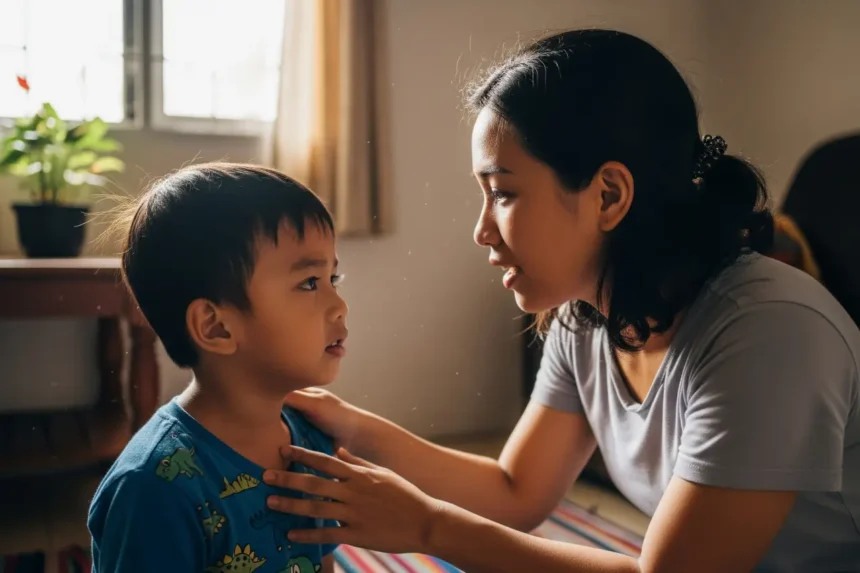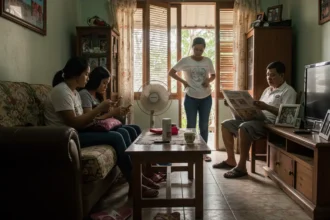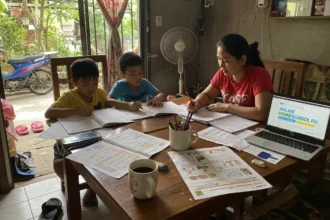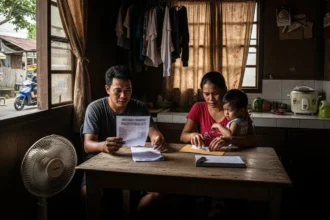Parenting in the Philippines carries a long tradition of strict discipline. Many of us grew up hearing lines like “Palo lang ‘yan para matuto.” The idea of spanking – or even the classic pamalo ng tsinelas – has been passed down for generations. But in today’s world, parents are rethinking this practice.
- Discipline in the Filipino Household
- 💡 Why Move Away from Spanking?
- ✅ Alternatives That Work in the Pinoy Context
- 📊 Spanking vs Non-Spanking: Quick Comparison
- 👪 Pinoy Parenting Hacks
- ❌ Common Discipline Mistakes to Avoid
- ✍️ A Parent’s Reflection
- Frequently Asked Questions about Discipline Without Spanking for Pinoy Parents
- ❤️ Raising With Discipline and Love
Is there a way to raise disciplined children without fear or pain? The answer is yes – and it works even better. Discipline is not punishment. It’s teaching, guiding, and helping your child grow into a responsible person. In a Pinoy context, it also means balancing respect (paggalang), values, and unconditional love.
Discipline in the Filipino Household
In the traditional bahay-kubo setup, parenting was straightforward: children were expected to follow orders without question, and elders held absolute authority. Respect for parents and grandparents wasn’t just encouraged – it was demanded. Disobedience, even in small things, was often met with a swift palo using a slipper, a belt, or sometimes even the famous tungkod ni lolo. For many Filipino families, spanking became the go-to shortcut to restore order.
But times have changed. Today’s Filipino parents are raising kids in a very different environment – one shaped not only by family traditions but also by global parenting trends, child psychology insights, and the ever-present influence of social media. The old belief that “kung hindi mo papaluin, lalaki ‘yang spoiled” is now being questioned. With laws like the Anti-Child Abuse Act in place, fear-based discipline no longer aligns with what most parents envision for their children. Instead, we want to raise kids who grow up with paggalang, empathy, and resilience – not fear and resentment.
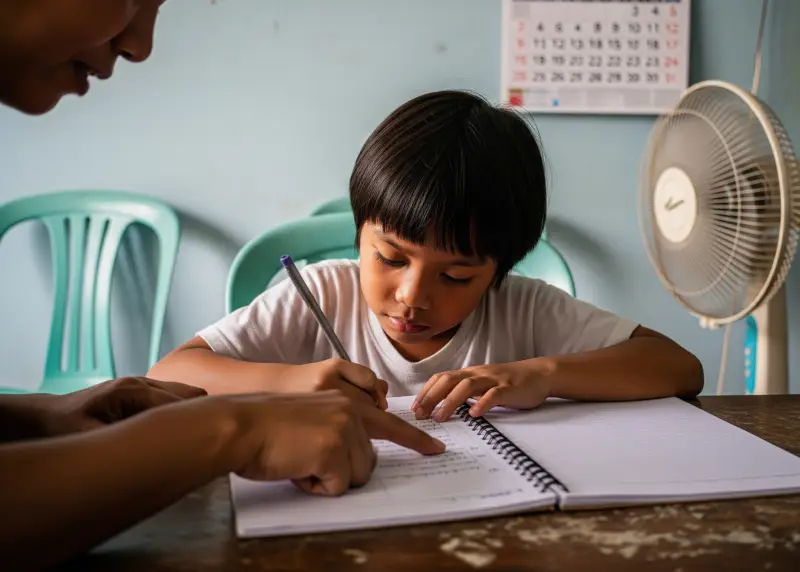
💡 Why Move Away from Spanking?
1. Fear vs. Respect
Spanking may bring immediate obedience, but it’s often rooted in fear rather than true respect. A child may stop misbehaving in the moment but fails to understand why the behavior is wrong. True discipline means guiding kids to make better choices, not just silencing them with fear.
2. Emotional Impact
Studies – and countless family stories – show that spanking can lead to aggression, insecurity, or bottled-up resentment. Some kids imitate the behavior, thinking hitting is the solution to problems. Others carry the trauma into adulthood, struggling with self-esteem and trust.
3. Cultural Pressure
In many Filipino homes, public discipline was once normalized: “Mapapahiya ka sa kapitbahay kung hindi ka sumunod.” But shaming a child in front of others may leave scars deeper than any physical pain. Instead of learning responsibility, the child learns embarrassment, fear of judgment, and a desire to rebel.
4. Legal Risks
Modern laws in the Philippines discourage physical punishment, and schools are strict about reporting possible abuse. What was once considered “normal parenting” can now be questioned legally. Beyond the law, there’s also a growing social stigma against physical punishment – neighbors, teachers, and even relatives may judge harshly.
✅ Alternatives That Work in the Pinoy Context
Discipline doesn’t have to mean spanking or shaming. In fact, Filipino parents today are discovering more effective (and often gentler) methods that still teach respect and responsibility while preserving the warmth of family bonds.
🗣 Talk It Out
Communication is one of the most underrated tools in parenting. Instead of barking orders or a quick palo, talking helps kids understand the why behind rules.
- Explain the Why – Replace the short “Huwag!” with a clear reason. For example: “Anak, bawal hawakan ang saksakan kasi delikado. Pwede kang makuryente.” Children respond better when they understand cause and effect.
- Active Listening – Discipline isn’t just about parents talking; it’s also about hearing kids out. A tantrum, more often than not, is just bottled-up frustration. Let them vent in words. Sometimes, listening already solves half the problem.
This approach teaches kids that rules aren’t about control – they’re about safety, respect, and care.
⚖ Natural & Logical Consequences
Instead of punishment, let children experience the direct consequences of their choices. This makes lessons stick without resentment.
Examples that work in a Filipino home:
- Toys left scattered? The toys “rest” for the day inside a box.
- Homework skipped? No TV or gadgets until it’s done.
- Fighting with a sibling? Both get extra chores – like folding laundry together – to learn teamwork.
By connecting action to outcome, kids learn responsibility, not fear. It also mirrors real life: actions always have consequences.
⏳ Time-In Instead of Time-Out
The Western “time-out” idea doesn’t always fit Pinoy homes – especially when there’s no extra room to send a child to. Instead, try time-in.
- Stay with your child. Sit down beside them and create a calm space.
- Name the emotion. Help them say, “Galit ako” or “Naiinis ako.”
- Guide, don’t exile. Use the moment to teach emotional regulation, not abandonment.
This technique works well in our close-knit culture where family presence is valued. Instead of isolating a child, you guide them through the storm of emotions until they calm down.
🌟 Positive Reinforcement
Instead of focusing only on mistakes, celebrate good behavior:
- “Ang ganda ng pagkakaayos mo ng gamit.”
- “Thank you for helping lola clean the table.”
Praise builds confidence and encourages children to repeat good behavior.

📊 Spanking vs Non-Spanking: Quick Comparison
| Discipline Method | Short-Term Effect | Long-Term Effect | Emotional Impact |
|---|---|---|---|
| Spanking | Instant obedience | Resentment, aggression | Fear, shame |
| Communication + Limits | Understanding | Sense of responsibility | Respect, trust |
| Positive Reinforcement | Encouragement | Habit-forming discipline | Confidence, happiness |
👪 Pinoy Parenting Hacks
Raising kids in the Philippines often means blending tradition with creativity. Parents have found clever ways to discipline with love, humor, and culture.
- Kuya/Ate Role Model – In most Filipino homes, younger kids copy their older siblings. If kuya does his chores without complaint or ate studies diligently, the little ones naturally follow. Use sibling influence as a positive force instead of rivalry.
- Pinoy Humor – Instead of scolding, parents often throw a witty banat or pabiro remark. Humor can lighten tension faster than a raised voice. A playful “Ikaw ha, para kang si Juan Tamad!” is sometimes more effective than nagging.
- Storytelling at Bedtime – Filipino parents pass down values through bedtime stories like Alamat ng Pinya or Maria Makiling. Lessons about respect, humility, and hard work slip in naturally when told as magical tales, making discipline feel less like a lecture.
- Reward with Time, Not Things – Kids may forget toys, but they’ll remember a family trip to Jollibee, a Saturday picnic, or an hour of undivided playtime. Connection outweighs material rewards every time.
❌ Common Discipline Mistakes to Avoid
Even with good intentions, some habits do more harm than good. Avoid these pitfalls that Filipino parents often fall into:
- Public Shaming – Saying “Nakakahiya ka, naririnig ka ng kapitbahay” may silence a child, but it leaves scars on self-esteem. Discipline should be private, not humiliating.
- Inconsistency – Allowing something today but forbidding it tomorrow confuses kids. Clear, consistent rules build trust and stability.
- Gadget as Babysitter – Handing a phone or tablet to stop a tantrum may work instantly, but it creates long-term dependency. Over time, gadgets replace parent-child interaction and reduce a child’s ability to self-soothe.
✍️ A Parent’s Reflection
As someone who grew up in a time when pamalo was considered normal, I’ve seen both sides: fear-driven obedience and respect earned through calm conversations. Now, raising my own child, I realize that patience, storytelling, and honest talks create lessons that stay longer than any sting of pain.
Frequently Asked Questions about Discipline Without Spanking for Pinoy Parents
- Why should Pinoy parents consider disciplining without spanking?
Because spanking might bring quick compliance, but it often leads to fear, shame, or emotional distance rather than true understanding. Kids learn better when they know why something is wrong, not just do this or else. Gentle discipline builds respect, empathy, and long-term trust. - What kinds of harm can spanking cause kids in the long run?
It can lead to aggression (they think hitting is okay), low self-esteem, anxiety, or resentment. Also, children might hide mistakes instead of owning them, because they want to avoid punishment rather than learn from behavior. - How do I talk to my child about rules without shouting or punishing?
Explain why the rule exists instead of just saying “Huwag!” For example, say: “Anak, hindi puwedeng hawakan ito kasi delikado, baka masaktan ka.” Listen too-sometimes kids just need to vent. When they feel heard, they’re more open to following what you ask. - What are natural or logical consequences, and how do these help in Filipino homes?
Natural/logical consequences are when a child faces the result of their action in a fair and related way-no arbitrary punishments. Like if toys are left all over, then they “rest” in the toy box; if homework is skipped, then no TV until it’s done. These teach responsibility without cruelty or fear. - What is “time-in” and how is it better than “time-out” for many Filipino families?
Time-in means staying close to your child during emotional moments-helping them name their feelings, calming together-instead of sending them away or isolating them. Since Filipinos value closeness and family presence, it feels more reassuring than punishment and helps kids learn to regulate emotions. - How can positive reinforcement work in disciplining Filipino children?
Instead of focusing only on mistakes, praise good behaviors-“Ang ganda ng pagkakaayos mo ng laruan” or “Thank you for helping lola.” Use charts, verbal appreciation, rewards of time together rather than toys. This builds confidence and motivates children to repeat good behavior. - What are simple parenting hacks that fit Filipino culture for discipline without spanking?
Use big-sibling role modeling (if kuya or ate does something good, younger ones follow). Employ humor or playful remarks to ease tension (“Parang si Juan Tamad ka ngayon!”). Use storytelling-myths or folk tales-to teach values like respect, honesty, and humility. Offer rewards of quality time instead of material things. - What are big mistakes Pinoy parents should avoid when disciplining?
Public shaming (saying “Nakakahiya ka sa kapitbahay”)-this can hurt self-esteem. Being inconsistent so kids never know what’s allowed when. Using gadgets as a quick way to stop tantrums, which can turn into dependency instead of helping the child learn to cope. - How does balancing firmness and empathy help in raising well-behaved Filipino kids?
Kids need boundaries and structure, or else they feel insecure. But empathy-understanding their feelings, giving explanations, being patient-helps them feel loved, seen, and safe. This balance fosters discipline that comes from understanding rather than fear. - How do parents shift mindset from “avoidable pain for obedience” to “teaching respect and values”?
Start by asking: what do I want my child to feel? Fear or trust? Then try alternative methods-talks, logical consequences, time-in, positive reinforcement. Reflect on your own childhood: which disciplinary moments you remember with respect, not shame. Gradually replace old practices with ones that build on love and understanding.
❤️ Raising With Discipline and Love
Discipline without spanking is not about being lenient – it’s about teaching with empathy and firmness. Filipino parents don’t have to lose disiplina just because we put aside physical punishment. Instead, we strengthen it by raising kids who understand why rules exist, not just fear breaking them.
At the end of the day, our goal is for children to grow up strong, compassionate, and proud of their Filipino roots. And that begins with the kind of discipline rooted in love.



